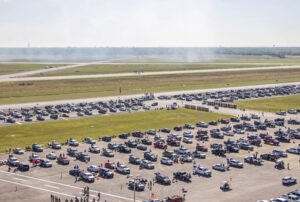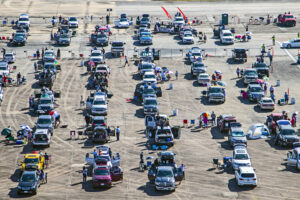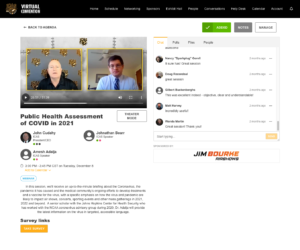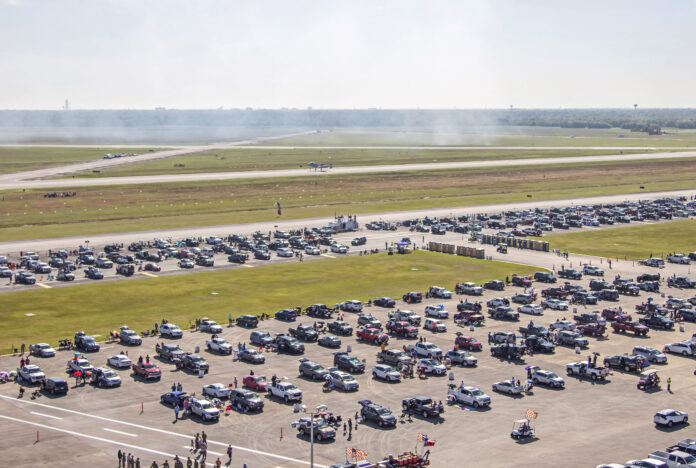By Collin Callahan
So far, 2021 looks very similar to 2020: many businesses closed, events of all sorts cancelled, and Americans donning masks for even the most mundane errands. But there is hope that things will soon change. Vaccines are being distributed around the world, and new research has provided insight into how COVID-19 spreads.

COVID-19 will affect the air show industry this year, and there is still a large amount of uncertainty about what will happen in the coming months. But there may be light at the end of the tunnel. Although experts have warned that things won’t be back to pre-pandemic norms for as long as two years, vaccinations and lower community spread of COVID-19 may usher in some semblance of normalcy.
Where we stand with COVID-19
Through the fall and into winter, health experts warned that coronavirus would wreak havoc. Unfortunately, those predictions held true as cases surged in North America and Europe. In January, the United States saw its highest daily death tolls of the pandemic, with seven-day averages hitting more than 3,400 deaths.
Additionally, new strains of the virus that causes COVID-19 were discovered in Brazil, South Africa, and the United Kingdom. Initial information about these mutations indicates that they are more easily transmitted, are possibly more lethal, and that vaccines are less effective against them. Researchers and health officials have expressed concern about the impact mutations will have on achieving herd immunity, saying they could extend the fight against the pandemic.
But in spite of the onslaught of negative news, there has also been positive news. The rate of new cases is dropping rapidly from post-holiday highs. And, almost immediately after the United States approved Pfizer and Moderna’s COVID-19 vaccines in December, a robust distribution network began delivering doses of the vaccines to states. There have been hiccups in the delivery process, but as of January 31, more than 25 million people had received the first dose of the vaccine in the U.S. Data from those vaccinations revealed no serious side effects. The Biden Administration said that, by the end of summer, anyone who wants to receive a vaccine will be able to get one.
Scientists have also collected more information about the way that COVID-19 passes from person to person and how to mitigate its spread. The virus that causes COVID-19 spreads through respiratory droplets, which an infected person releases when they cough, talk or breathe.
The biggest opportunity for the virus to spread is indoors with minimal ventilation, social distancing or mask wearing. In New York, state officials released the results of contact tracing showing that 74 percent of viral transmission occurred at indoor social gatherings.

“Social interaction with other individuals is an opportunity for the virus to jump from one person to another,” Dr. Amesh Adalja told attendees at ICAS’s virtual convention in December. Adalja is a senior scholar at Johns Hopkins Center for Health Security who specializes in infectious disease. He worked with the NCAA coronavirus advisory group last year. “So the simple things — like trying to keep people six feet apart, having people wear face coverings when they can’t social distance, a lot of hand washing and trying to avoid extremely congregated or crowded places — all of that is going to go a long way to preventing spread in the community.”
Even with vaccines, social distancing and masking is still important. Vaccines don’t necessarily prevent infection or transmission of coronavirus; they prepare the body to fight the virus should it be contracted, lowering the risk of severe cases that necessitate hospitalizations. A vaccinated individual can still pass the virus to others.
Still, vaccines should help establish herd immunity. Researchers at Columbia University released a paper in January showing that with current mitigation policies and vaccination efforts, new cases of COVID-19 could drop to near-zero levels by summer. However, the modelling on which the paper is based did not include more transmittable mutations of the virus, and the paper has not been peer reviewed.
What does this mean for air shows?
It is important not to put too much emphasis on the positive news and too little emphasis on the negative news, but there is room for optimism about the coming air show season.

“I do think that you can have events like air shows in a responsible manner,” Adalja said. “Respecting the guidelines that the [Centers for Disease Control] has put out and trying to keep your attendees from spreading the virus, by having them wear face coverings. wash their hands a lot, trying to keep parties apart by six feet. Just having people be very respectful of each other’s space, I think, will go a long way to allow us to allow these types of activities to occur.”
Health officials and public policy makers have recognized that outdoor activities don’t pose the same threat that of viral transmission that indoor activities do. That’s because viral particles released into the air outside are dissipated by the wind, lowering the risk that an infected person can spread the virus to others.
“A major factor in terms of decreasing that transmission risk is to have a great deal of ventilation so that the viral particles are diluted in the air and they leave the immediate area,” said Dr. Jonathan Bearr, a health scientist at the Occupational Safety and Health Administration who holds a Ph.D. in toxicology. Bearr also spoke to ICAS members at this year’s virtual convention. “When you look at indoor versus outdoor events, outdoor events, to a large extent, effectively have unlimited ventilation; everything’s blowing around. And so what you would expect from an outdoor event would be far less transmission, that the risk would be much lower.”
There is also anecdotal evidence to support that conclusion. Several air shows were held last season with limited, socially distanced crowds, and no reports of COVID infection spikes related to any of the events. Thousands of fans attended NFL games this season, and none of those games became “super-spreader” events. Out of 128,000 people who attended Dallas Cowboys games through mid-November, eight people later tested positive for coronavirus. It’s unclear if they contracted it at the game or elsewhere. Even the Buffalo Bills were able to work with one of the strictest states in the nation to allow 6,700 fans to attend the team’s first home playoff game in 24 years.
Although outdoor events lower the risk of transmission, they don’t eliminate it. The Centers for Disease Control recommends that people wear masks in public settings when they will be around other people. Masks offer protection by cutting the amount of droplets — which convey coronavirus — that one expels, and they offer some protection in the event the mask wearer encounters a contagious individual.

As part of their remarks during the 2020 Virtual ICAS Convention, both Bearr and Adalja recommended a combination of masking and social distancing at air shows, eliminating places where people can crowd and congregate, and using multiple entrances and exits to limit choke points.
“You can’t wear a mask and think that you can go anywhere,” Bearr explained. “You have to layer it with other precautions, such as physical distancing. You have to layer it with things like hand hygiene. When you layer all these things together, it becomes a much more robust and effective way to prevent infections.”
Perhaps most importantly, air show organizers should communicate expectations to performers, sponsors, volunteers, vendors, and attendees well before the air show.
“I think, by far, the most important part of this is communication,” Bearr said. “Forgive the pun, but we need to give folks a long runway to get used to all of the new behaviors we expect. We need to be able to communicate that to the attendees, to the vendors, to the people who are working directly for you all leading up to the event. They all need to be aware; there should be no surprises when anyone arrives on the day of the show. And that’s one of the most important things to consider.”
While the threat of COVID-19 is far from over, this year should allow the air show industry to start its recovery from the gut punch that last year was. Scores of events have demonstrated that — with proper safety measures in place — air shows can be held without major risk of spreading coronavirus. As vaccination rates increase and transmission rates decline, regions with more stringent restrictions in place should begin to ease those restrictions. The coming air show season won’t be easy, but hopefully it offers the chance to return to normalcy.








